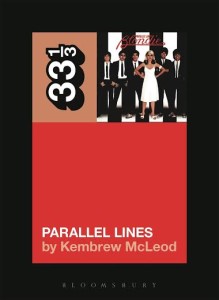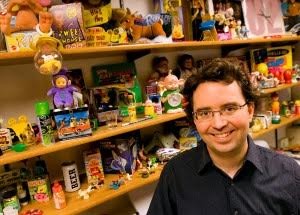Kembrew McLeod is a Professor of Communication Studies at the University of Iowa. He is a prolific author, filmmaker, and prankster. His latest book is Blondie’s Parallel Lines (Bloomsbury, 2016) the 111th book in 33 1/3’s series on classic albums. Brad de Roo nerded out via email to get to some intersecting lines from Kembrew McLeod for carte blanche this April.
You’ve written books and produced documentaries about freedom of expression, independent media, and copyright law. How does this book intersect with these concerns?
At the heart of all my books and documentaries is a desire to understand how artists create music, art and culture—all while working within (and rising above) various constraints. In the case of the most recent documentary I co-produced, Copyright Criminals, I was interested in how legal and music business rules changed the way hip-hop artists sampled and made their music, as well as how they found creative workarounds.
My book on Blondie’s Parallel Lines similarly examines how Debbie Harry and company worked within commercial constraints to bring their underground brand of punk-infused pop to a mainstream audience. In doing so, I interviewed the core founding members of the group—nerding out by asking them extensive questions about the downtown scene they emerged from, and also very specific queries about how they recorded Parallel Lines.
You are a fan of pranks, especially those of the robo-variety. Has your pranking/protesting style been in anyway influenced by some of the subversive 60’s and 70’s NYC performance art that you depict in this book?
Yippie prankster Paul Krassner was one of my first introductions to that downtown New York world—first with his interview in the classic RE/Search book Pranks and later, his memoir (I have since interviewed him a few times). But my interest in pranking largely predated that awareness, for I have been making mischief from a young age. However, the more I have learned about those radical downtown pranksters and performance artists, the more I realize that they are my demented spiritual ancestors. These are my people!
You argue that Blondie, the playful image invoked by Deborah Harry, was often co-opted by masculine corporate forces. Do any of these distortions or misrepresentations of her image persist? Do you see any current gender-troubling musical leads that are fighting comparable forces?
I think with the growing acceptance of gay and trans identities, Debbie Harry is now better understood on her own iconoclastic terms—rather than through the distorted funhouse mirrors of the culture industry. Today, artists have more freedom to trouble gender binaries, thanks in part to Debbie Harry and David Bowie in the 1970s, and Prince in the 1980s.
The NYC scenes of the Factory, Max’s Kansas City, CBGB, and Studio 54, seem so wild and eclectic. Do you see anything like them persisting today? Are they part of some greater American tradition of musical and cultural interaction?
Warhol’s Factory, Max’s, CBGB, Club 82, and Studio 54 all coexisted in the same city, around the same time, largely because New York was still an affordable place to live as an artist or musician. It was a singular moment of time that—due to social and economic reasons—likely won’t be replicated in that city in my lifetime.
How much of Blondie’s success is a result of the inclusiveness of its band members?
Debbie Harry and Blondie guitarist Chris Stein had open ears, open enough to choose to do a Kraftwerk-esque Euro-Disco track like “Heart of Glass.” Significantly, it was the band’s first big breakthrough in the United States after having over half a dozen singles fail to crack the Billboard Top 40. The band’s other biggest hits, such as “Rapture” and “Tide Is High,” also owe their success to the Blondie’s openness and inclusiveness.
What sets Parallel Lines apart from other Blondie albums?
It’s the group’s tightest album, not an ounce of fat or filler on it. Producer Mike Chapman’s involvement in Parallel Lines shows what a difference the right producer can make. Ideally, they can push artists to strike a balance between rehearsed polish and spontaneity, expanding a song’s popular appeal while retaining its visceral impact. By adding layers of sonic sweetness, they can also help bitter lyrical pills go down more smoothly.
Do you have favourite songs from it? Why?
Where to begin? “Pretty Baby” is about as perfect a pop moment an artist could ever conjure, especially when Chapman’s wall-of-sound production swells during the song’s multi-tracked refrain. It sounds like a chorus of Debbie Harries lovingly wrapping the listener in a warm sonic blanket. But to be perfectly honest, Parallel Lines isn’t my favourite Blondie album. That would be their self-titled debut, Blondie, which was the first time I fell in love with the group. The reason I wrote about Parallel Lines for the 33 1/3 series is because it was a more interesting moment in the group’s career—and pop culture, more generally—which allowed me to compare and contrast the group’s breakthrough album with the underground roots they emerged from.
Was it all challenging or daunting to write a book that is part of such a large, continuing series? How conscious of the other books were you while writing? Without necessarily getting too particular, were there any templates or approaches you aimed to avoid from the outset?
One thing I didn’t want to do is write a book about why Parallel Lines was important to me, personally. While a more autobiographical approach has been done successfully in the series (Prince’s Sign O The Times by Michelangelo Matos or Talking Heads’ Fear of Music by Jonathan Lethem, to name a couple excellent examples), I think it can also be done badly. Some of the models I worked in developing my 33 1/3 book were Carl Wilson’s Let’s Talk About Love, Don McLeese’s Kick Out the Jams, and Christopher R. Weingarten’s It Takes a Nation of Millions to Hold Us Back. These books nicely placed the production, dissemination, and reception of their respective albums within a larger social context. Wilson’s book on Celine Dion lines up closest with my own book project, because both are concerned with how hierarchies of taste develop within popular culture—and how those hierarchies can marginalize certain groups of people.
The members of Blondie, as well as many other figures from the scene were quite outspoken. How was interviewing them? Did you feel any topics were out of bounds? Do you have any memorable stories related to the interview processes?
The four founding members of Blondie—Debbie Harry, Chris Stein, Clem Burke, and Gary Valentine—were all very accommodating and generous with their time. I’d like to think that they were so open because I didn’t ask the same old clichéd questions, and I didn’t feel like there was anything I couldn’t ask. The only limitations or walls I ran into were when memories failed, but that’s where good archival research comes in handy!
What the heck is going on in American politics right now? Should Deborah Harry run for president next time?
Actually, I’m a big Donald Trump supporter, but would settle for Ted Cruz. (Kidding, kidding.)
Is there anything else on your mind that I glaringly missed or that at this moment consumes you?
I’m currently writing and researching a book the will more fully examine downtown New York City in the 1960s and 1970s, because my interviews and archival research yielded so much interesting stuff that I couldn’t cram into this little 33 1/3 book. It’s tentatively titled The Pop Underground. Look for it in 2018!

